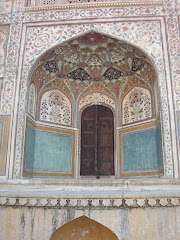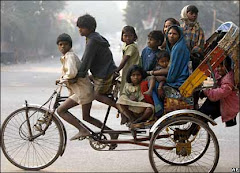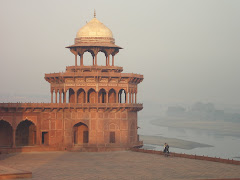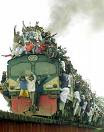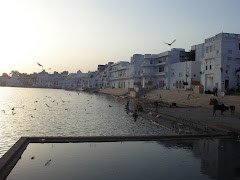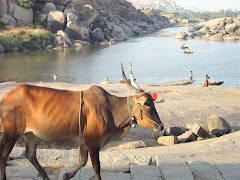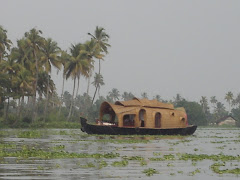Monday, December 8, 2008
India: The Elephant in the Room
Now one of Mumbai’s iconic landmarks, the Taj stands in regal splendour at the mouth of Mumbai’s harbour. With over 470 rooms, the Taj’s glory is evident in the marble flooring, extravagant chandeliers and water fountains that decorate its rooms along with the impeccable service delivered in its several bars and restaurants. Mumbai residents proudly adore the sumptuous hotel and its addition of beautiful to the city.
My English grandparents lived in India during the 1930’s through to the 1950’s; and my Indian-born father clearly remembers weekly visits to the Taj for Sunday Afternoon Teas as a small boy. I have made the Taj my second home in this city, getting to know staff, using it both personally and professionally – including to ward off the occasional bout of homesickness. Watching it burn from my apartment in Colaba, directly at the epicenter of the terrorist attacks of the past week, was heartbreaking.
What impact the recent events will have on foreign entities and their investment within the subcontinent? Although some of our New Zealand and Australian expat community were directly caught up in the bloody events, it is with relief that I can report that none have lost their lives. Although the targets were extensively used by all of the various communities living and working within Mumbai, it is sadly by and large Indian colleagues, friends and associates who paid the ultimate price. Everyone seems to know someone directly affected.
To date there have been a few cancelled visits by new entrant companies in light of the terror. I am heartened to see that existing and new business plans slightly further down the track than those who are just putting their big toes in the market are still continuing with their plans.
According to Indian industry experts, the Indian economy should bounce back from both the financial crisis fallout and the recent terror attacks sooner than anticipated. Unlike the US or European economies, India has several things already in its favour. The impact of the global financial crisis is forecast to remain fairly limited due to the strong demand for consumption within the economy, the demographic advantage and the strength of the Indian financial system.
Principle areas of investment continue to remain within the infrastructure sector; an area which was sorely overlooked from Independence in 1947 until the early 1990’s, leaving India in concentrated catch up mode to ensure it can seriously compete with the major players in the global economy. Core requirements being the creation of modern highways; and significant investment sought in railways, airports, bridges and port facilities. FDI is approved to 100% in this sector.
Other areas of increasing activity include financial services, real estate, education, healthcare, manufacturing, hospitality, tourism and entertainment; along with a range of sectors that are directly attributed to by the dramatic growth of India’s middle class. For the first time in India’s history large numbers of people have disposable income. With over 50% of the 1.2 billion population under the age of 25 years, these core requirements will dramatically increase as India assumes its greater role in the global economy. In addition, inflation appears to be leveling out with a decline over the past few weeks.
Politics here are an interesting beast, with elections going on in some states currently, and the new government due to be named in the first few months of 2009. It is expected to be another coalition government. The country’s growth, despite a recent drop in GDP, is still estimated to remain within a healthy 7-8% with continued steady growth predicted in both incoming and outgoing investment. FDI flow has been $6.5 billion for the first five months of the current financial year, against $2.7 billion for the same period in the previous year.
It is hard to say how the recent events of the past few days will affect the outcome of the elections. As I write this, it is exactly a week from when the terrorist siege of Mumbai began, heads are rolling and there is a lot of shuffling within government. The people of India are clearly expressing their views on what is required in the form of Gandhi-inspired peaceful marches and rallies, primarily orchestrated by youth. It is interesting to note there appears to be a major change in reaction to the past few days horrific events when compared with the aftermath of previous terrorist activity within this country. There has, for the first time, been no consequential civil unrest between opposing sectors of society within the city itself to date. All sides of society appear to be in agreement that infrastructure for the police, military and security personnel, including more accountability, are top of the agenda.
The New Zealand government continues to develop closer ties with India through ongoing talks seeking a Free Trade Agreement between the two countries, with India being in the top three countries currently being targeted by New Zealand. Government representatives here in India are actively supporting New Zealand companies, along with a pool of expatriated professionals, including New Zealand citizens based here in India specifically to assist in foreign company requirements from on the ground. This means that there are other options available to entities looking to enter this market, without having to have an actual physical presence, avoiding potentially high cost and downtime relocating their own employees, thus minimizing risk.
As a foreign company looking to this market, you would most certainly be wise to carefully evaluate your plans at this point. Despite a slight lull due to both the financial crisis and the recent terrorist activity in the country’s commercial capital, the feeling is that business will carry on as normal with no major change expected in the medium to long term for both inbound and outbound investment in India.
And on a closing note, having lived in Mumbai for the past two years, I can assure companies and individuals that I have never once felt hostility towards myself or any other foreigner. On the contrary, from business leaders to industry heads right down to the man on the street, foreign presence, investment and assistance within this country is welcomed with enthusiasm and interest.
India is still the elephant in the room.
Wednesday, September 24, 2008
PepsiCo Commitment to India
Amidst the scrambling abroad in response to the Lehman crisis; PepsiCo quietly announce their commitment to a further 500m USD investment in the Indian market over the next three years; which is forecast to triple PepsiCo's existing business here within India over the next five years.
Entering the Indian market in 1988-89, PepsiCo India is currently ranked the fourth largest consumer company in the country. Originally entering via a joint venture with a Punjabi government-owned organisation and another local company, it was initially bound to rename its brand as Lehar Pepsi until the government relaxation of the rules which allowed foreign brands into the country in 1991. PepsiCo consequently bought out their partners, and continued to grow its market share at an impressive rate.
Hampered in recent years by ongoing scandals concerning the quantity of pesticides within their products within India, both the Coca-Cola Company and PepsiCo joined hands in 2005 (with 95% hold on the soft drink market in India between them) to fight the allegations of toxicity within their products that are manufactured here.
Social responsibility for a company of this size, doing business in a developing country such as India is indeed large and should not be overlooked. One would assume that a chunk of the investment that PepsiCo is pouring into India would go to ensuring water quality in its manufacturing plants, and an investment into pesticide residue reduction or the development of alternatives to pesticides to ensure that the quality and standards of its product are as high a standard here, as they have to be in other countries.
The main problem appears to be the unregulated use of pesticides in India, and the ground water which the bottling plants use in the manufacture of its products. Seepage is hard to determine, and difficult to control, however with the current pesticide residue's found in both Pepsi and Coke products being highly carcinogenic and way above acceptable quantities in any other country - it would seem to me that PepsiCo (& The Coca-Cola Company) had a major responsibility to conduct and act on responsible solutions to solve the problem. In other words, their responsibility here goes far deeper than just their stakeholders pockets.
Perhaps working WITH the government to establish regulation of pesticide use and food quality control could be a start??
India ranks among the top ten markets overall in dollar terms for PepsiCo; and being among the top 5 markets in terms of consumer purchasing power. PepsiCo Chairman and CEO Ms Indra Nooyi states that the Indian market is a very substantial one whose prospects PepsiCo were bullish about.
I look forward to seeing the effects of PepsiCo's $500m USD investment into India, and their contribution to the countries growth in a transparent and accountable way.
Tuesday, September 9, 2008
The Ambani's, Mars and Mothers
 Above is a picture of the the Ambani's in happier times. Founder of Reliance, Mr Dhirubhai Ambani is seated, from left to right standing behind him is Mukesh Ambani, Bill Clinton and Anil Ambani.
Above is a picture of the the Ambani's in happier times. Founder of Reliance, Mr Dhirubhai Ambani is seated, from left to right standing behind him is Mukesh Ambani, Bill Clinton and Anil Ambani.You cannot be conducting business in India for long, without hearing stories about, and references to, the fabulous Ambani family. Listed in 5th and 6th place respectively in the Forbes Rich List, the Ambani’s are incredibly wealthy, flamboyant, politically active and are constant media fodder in terms of their in-house rivalries. The story of this family is the stuff that great cinematic tales are made of. I can only assume that no movie has been made to date, as this story just isn’t over yet...!
This story starts with Dhirajlal Hirachand Ambani , known as Dhirubhai, son of a modest school teacher, born in 1933, and a school drop out - at a time when most of India’s large domestic privately held companies were run by men born of wealth. Building a USD 15 billion empire, this unlikely candidate was to become India’s most remarkable businessman. Ever.
After a stint working in Yemen, Mr Dhirubhai Ambani returned to India in 1962 and founded Reliance with Rs 15,000 (USD 350), initially formed as a textile trading company. Aggressively growing the company, he displayed his acute business acumen taking the company public on the Bombay Stock Exchange in 1977, when Mr Ambani managed to convince millions of middle-class Indians to buy stock (in Reliance) for the first time.
Ambani was famously quoted as saying that he was deaf to the word ‘no’ at a time when corporate India was struggling under over zealous and ill thought out government bureaucracy during the 1980’s, nicknamed the License Raj, which severely restrained the production capacity of private sector companies within India at the time.
As a result of Ambani’s strong leadership, Reliance grew exponentially, as did its stockholders wealth. By 2002, original investors in Reliance had earned 43% per year compounded annual rate of return, and Reliance became the first Indian private-sector company to enter the Fortune 500.
That same year, Mr Dhirubhai Ambani died without leaving a will.
Enter his two sons. Mr Dhirubhai Ambani’s eldest son, Mukesh was promptly elected company chairman, but rumours of discontent between he and his brother Anil began circulating. Viewed as a direct challenge to Mukesh, Anil promptly allied himself with a northern Indian political party, earning himself a seat in India’s upper house of parliament. Reports of the Reliance heir apparent discord abounded and were finally confirmed with a press statement by Mukesh Ambani.
This public admission of rivalry and dispute between the two brothers put 3 million Reliance stockholders on edge, which in turn made the company’s customers, vendors, employees and even government officials nervous. The two rival camps leaked stories about the other to media, who lapped up the story. Concerned banker friends, cabinet ministers, family members and board members all visited the Ambani’s to resolve the differences, to no avail. Months went by with on-going media frenzy through daily headlines from each of the contentious camps. Most people assumed that Reliance’s best days were over.
In March 2005 there was a breakthrough of sorts – in unique Indian fashion. An esteemed astrologer made a prediction in the largest circulating English-language newspaper of India that both brothers would become successful and that Reliance would do better in future times to come. He blamed the planet Mars for their troubles, and stated that Mukesh and Anil Ambani would resolve their differences by spring.
As if on cue, three months later, Kokilabhen Ambani (Dhirubhai’s widow and mother of the two boys) publically declared an amicable split of the Reliance fortune between Mukesh and Anil. It has to be noted that Kokilabhen had consulted religious astrologers well into the night before the announcement. The day of the announcement, the Sensex (India’s version of the Dow Jones Industrial Average) soured to a record high as Indians showed their support in a celebration of the power of motherhood and astrology to resolve disputes.
To western eyes that are unfamiliar with the depth of religious and family involvement in all levels of life in India, this would be hard to comprehend. To do business in India, it is paramount to accept (if not completely understand) that decisions are often based on auspicious dates and that you may be only dealing with one person on the surface, but their decisions will involve (most likely senior) family members.
This won’t affect you reaching your goals, but it may go some way to explaining why negotiations can be drawn out longer than you are used to in the west, and why you may feel that you have achieved nothing in your initial meetings as business was not discussed to the depth that you would have liked. Business in India is about relationships. You need to work on your relationship with your local business partner and as with all relationships; there will be a honeymoon period as your partner gets to know you. Once that relationship is formed, if you have put in the effort, time and patience – you may be surprised at the depth of passion and commitment that your Indian partner will consequently put into the relationship to ensure success and value to all concerned.
The Ambani story continues. Both Mukesh (Reliance Industries) and Anil (Reliance Anil Dhirubhai Ambani Group) have grown their respective businesses despite the seemingly on-going and vocal friction between both parties. Only two weeks ago, in a dispute at the High Court in Mumbai between the brothers, the judge ordered both parties to go and talk with their mother. On reading this, I immediately SMSed a friend to giggle about how cute it sounded that these men who both sit within the top six of the worlds global rich list, and who are responsible for millions of investors, employees and enormous business interests respectively were ordered to seek their mothers wise council!
Being a mother, I like that judgment enormously!
Expect the unexpected in India, but don’t let that put you off.
Monday, September 8, 2008
What the Indo-US Nuk Deal Means
 Left is a picture of Indian Prime Minister Dr. Manmohan Singh, in a rare show of emotion, upon reaching Indian parliament this morning!
Left is a picture of Indian Prime Minister Dr. Manmohan Singh, in a rare show of emotion, upon reaching Indian parliament this morning!  ost daily international and political dramas for both interested parties unfolding as it moves through the various stages on its way to becoming the reality which it now appears that it will become.
ost daily international and political dramas for both interested parties unfolding as it moves through the various stages on its way to becoming the reality which it now appears that it will become.Friday, September 5, 2008
Tick Tock for the Royal Bengal Tiger...

What of the hunting, hunter bold?
I like to see a wild animal acting like a wild animal - therefore the above video link appeals to me, despite its attack on the boats, which are the only form of transport into the area where this video was shot! The  video above was filmed in the Sundarban National Wildlife Park, which is a most impressive wildlife park within India. The Sundarbans cover 140,000 hectares of pristine forestation in the Ganges Delta. It spans across both India and Bangladesh, with the majority of the area being made up of wetlands and mangrove forest. The largest population of wild Royal Bengal Tiger's are located within this park.
video above was filmed in the Sundarban National Wildlife Park, which is a most impressive wildlife park within India. The Sundarbans cover 140,000 hectares of pristine forestation in the Ganges Delta. It spans across both India and Bangladesh, with the majority of the area being made up of wetlands and mangrove forest. The largest population of wild Royal Bengal Tiger's are located within this park.
The name Sundarbans means 'beautiful jungle' and the area has been under systematic management since the 1860's, with the forest now being a National Park, a Tiger Reserve, an UNESCO World Heritage Site and a Biosphere Reserve.
Management and the footsoldiers on the grounds within the park face an enormous task in protecting the park due to its location falling over two international borders; the location of many villages and tribal people living within the park on both sides of the borders; limited funds; and with constant threat of poachers who can get a small fortune for tiger parts to sell in countries such as China for use in medications, virility potions and whatnot. These various organisations (including government) have a very hard task indeed to maintain the balance for the many endangered species, flora and fauna which still exist in this delicate ecosystem, including the Royal Bengal Tiger.
The tiger has always been greatly respected within India, with it being represented extensively in religious symbolism and government emblems, as well as by the Indian nation at large in many forms. Coming from a country where we have a cute fat beloved flightless brown bird as our national icon, I cannot help being slightly jealous of India having the wonderful regal mysterious, strong and powerful tiger as its symbol!
In India's quest to become a veritable tiger on the world stage, I sincerely hope the powers that be (in conjunction with the international contributors) are able to increase their efforts to save the remaining tigers before it is too late.
The clock ticks loudly for the Royal Bengal Tiger...
Thursday, September 4, 2008
R.I.P. Shri Thomas Bata ji

Sunday, August 31, 2008
What is this Bollywood business?

The media coverage is incredibly extensive, with even the dry old crusty daily newspaper tomes dedicating at least one of their pages each day to these wonderfully sparkly people of Bollywood. There are a multitude of celebrity talk shows and interviews on various television channels; and I even saw one headline news story of a reputable national news channel filming and interviewing one of the special people getting a hair cut - I kid you not (and not as per a Brittany haircut scandal...no, no, no - this was merely a Bollywood dude getting a regular haircut!)
Unlike a Hollywood release; the entire nation of India watches with extreme interest and baited breath as each new movie is spewed out the end of the very fertile machine that is Bollywood. The majo rity of films stick rigidly to the proven formula...always with a minimum of two or three large dance sequences, and stories based around themes of love. I have noticed an amazing tendency for Bollywood to shoot love scenes in the rain. I am assuming this is by and large due to a very vocal moral society which simply would not condone bawdy sex scenes...instead substituting highly emotive and impassioned rain scenes, suggestively allowing the viewer to fill in the blanks (no pun intended).
rity of films stick rigidly to the proven formula...always with a minimum of two or three large dance sequences, and stories based around themes of love. I have noticed an amazing tendency for Bollywood to shoot love scenes in the rain. I am assuming this is by and large due to a very vocal moral society which simply would not condone bawdy sex scenes...instead substituting highly emotive and impassioned rain scenes, suggestively allowing the viewer to fill in the blanks (no pun intended).
 ie, Zee, Pix, Hallmark and World Movie sattelite tv channels.
ie, Zee, Pix, Hallmark and World Movie sattelite tv channels.The Remarkable Story of Infosys

Thursday, August 21, 2008
Happy Independence Day India!

Monday, August 4, 2008
Beauracracy in India
Having experience in the western world where business speed, efficiency and delivery are our Gods, it is indeed hard to fathom that India still retains a system which it inherited from the British sixty years ago, which remains largely unchanged. It is indeed true that it remains a largely paper based system, with many many government or state employees each servicing just their specific task in the process, all relying on each other to move your paperwork through their system, thereby causing some major time delays as each person checks off their very specific part of the process before forwarding your document to the next person in the cycle.
I personally found it excrutiatingly difficult to relate back to my home office when I first arrived in India why we were waiting days, weeks and sometimes months for core business set up processes to be completed. If you are sending your faithful company representatives here to act on your behalf, please be gentle and understanding as the beauracracy can be simply tear-inducing, and it certainly adds an additional level of stress to your people who are already coping with a dramatically different society!
The problem with implementing the change is not lack of inspiration or desire, it is more that India is an enormous country, divided into many different states, cultures and languages - making the implementation of change here a truely mammoth and unenviable process.
Implementation of faster and less draconian processes will also result in putting a great many of those employed out of a job. In India, a government job is considered a "job for life". So there is social change and responsibility that comes into play here as well. The decision makers sit on the fence between great pressure to continue opening up to competition and to improve services at every level, as well as managing this change in a vocal, politically aware and long established sector.
It is with anticipation that I read in the media that some areas of current government and state service sectors are to be opened to private contractors. Exact areas where such opening up will be is currently being determined through an extensive exercise identifying areas where the existing monopoly of functions can be tempered with competition.
The government does outsource some services, however this new initiative is fundamentally different as it invites private parties for the first time to contract the provision of services back to the government. Opening up to competition, and therefore improving service.
The introduction and provision of online services and submissions is growing, so it is not intention that is lacking here, it is merely the difficulty of navigating the complex path of change in a responsible way.
I expect the recurring conversations with foreign companies and individuals doing business here to continue for a while yet, regarding their frustrations at the beauracratic processes and the often long delays in the lifecycle of basic submissions. Change will not happen overnight, however I can assure you that it is happening.
In the meantime: business continues, opportunities remain intoxicating, plentiful and diverse across all sectors - and the current struggles with beauracracy is not reason enough to frighten foreign investors off.






